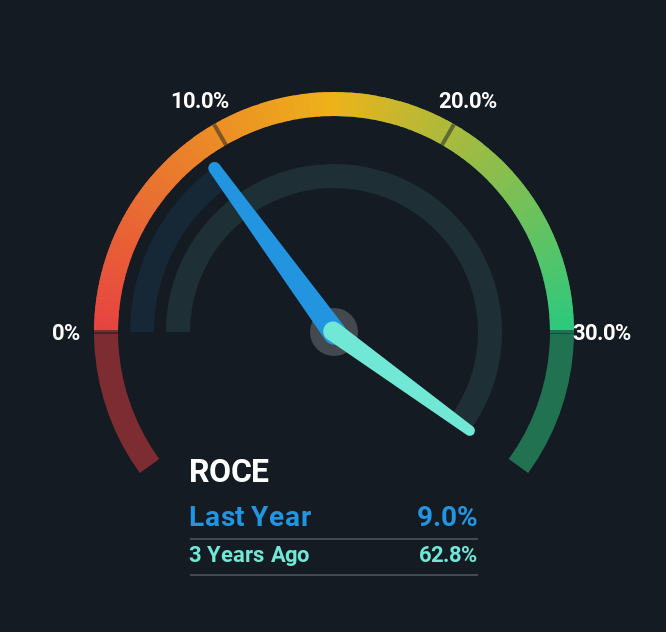- South Korea
- /
- Chemicals
- /
- KOSE:A298020
There Are Reasons To Feel Uneasy About Hyosung TNC's (KRX:298020) Returns On Capital
What trends should we look for it we want to identify stocks that can multiply in value over the long term? One common approach is to try and find a company with returns on capital employed (ROCE) that are increasing, in conjunction with a growing amount of capital employed. If you see this, it typically means it's a company with a great business model and plenty of profitable reinvestment opportunities. In light of that, when we looked at Hyosung TNC (KRX:298020) and its ROCE trend, we weren't exactly thrilled.
Return On Capital Employed (ROCE): What Is It?
For those who don't know, ROCE is a measure of a company's yearly pre-tax profit (its return), relative to the capital employed in the business. The formula for this calculation on Hyosung TNC is:
Return on Capital Employed = Earnings Before Interest and Tax (EBIT) ÷ (Total Assets - Current Liabilities)
0.09 = ₩272b ÷ (₩5.7t - ₩2.6t) (Based on the trailing twelve months to March 2025).
Therefore, Hyosung TNC has an ROCE of 9.0%. In absolute terms, that's a low return, but it's much better than the Chemicals industry average of 7.3%.
See our latest analysis for Hyosung TNC

Above you can see how the current ROCE for Hyosung TNC compares to its prior returns on capital, but there's only so much you can tell from the past. If you'd like to see what analysts are forecasting going forward, you should check out our free analyst report for Hyosung TNC .
What Can We Tell From Hyosung TNC's ROCE Trend?
On the surface, the trend of ROCE at Hyosung TNC doesn't inspire confidence. To be more specific, ROCE has fallen from 30% over the last five years. On the other hand, the company has been employing more capital without a corresponding improvement in sales in the last year, which could suggest these investments are longer term plays. It's worth keeping an eye on the company's earnings from here on to see if these investments do end up contributing to the bottom line.
On a side note, Hyosung TNC has done well to pay down its current liabilities to 47% of total assets. So we could link some of this to the decrease in ROCE. What's more, this can reduce some aspects of risk to the business because now the company's suppliers or short-term creditors are funding less of its operations. Since the business is basically funding more of its operations with it's own money, you could argue this has made the business less efficient at generating ROCE. Either way, they're still at a pretty high level, so we'd like to see them fall further if possible.
What We Can Learn From Hyosung TNC's ROCE
In summary, Hyosung TNC is reinvesting funds back into the business for growth but unfortunately it looks like sales haven't increased much just yet. Investors must think there's better things to come because the stock has knocked it out of the park, delivering a 154% gain to shareholders who have held over the last five years. But if the trajectory of these underlying trends continue, we think the likelihood of it being a multi-bagger from here isn't high.
Like most companies, Hyosung TNC does come with some risks, and we've found 2 warning signs that you should be aware of.
While Hyosung TNC isn't earning the highest return, check out this free list of companies that are earning high returns on equity with solid balance sheets.
Valuation is complex, but we're here to simplify it.
Discover if Hyosung TNC might be undervalued or overvalued with our detailed analysis, featuring fair value estimates, potential risks, dividends, insider trades, and its financial condition.
Access Free AnalysisHave feedback on this article? Concerned about the content? Get in touch with us directly. Alternatively, email editorial-team (at) simplywallst.com.
This article by Simply Wall St is general in nature. We provide commentary based on historical data and analyst forecasts only using an unbiased methodology and our articles are not intended to be financial advice. It does not constitute a recommendation to buy or sell any stock, and does not take account of your objectives, or your financial situation. We aim to bring you long-term focused analysis driven by fundamental data. Note that our analysis may not factor in the latest price-sensitive company announcements or qualitative material. Simply Wall St has no position in any stocks mentioned.
About KOSE:A298020
Hyosung TNC
Manufactures and sells fiber in South Korea and internationally.
Undervalued with adequate balance sheet and pays a dividend.
Market Insights
Community Narratives



